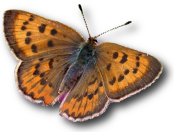 Art Shapiro's Butterfly Site
Art Shapiro's Butterfly Site
Monitoring butterfly populations across Central California for more than 35 years… Epargyreus clarus
Common Name: Silver-Spotted Skipper

Locally common in the Western Sierra foothills and in the Coast Range north of the Bay. Formerly present (very locally) in the Sacramento Valley, but there are no current records. Found in riparian habitats, often in canyon bottoms, but something of a fixture in Gold Country towns where it breeds on introduced Black Locust (see below). There is nothing else in our fauna that can be confused with it.
A very strong flier, the silver patch flashing in the sun as it moves through dappled light and shade. An avid visitor to Milkweed, Dogbane, Yerba Santa, native perennial Vetches, California Buckeye and garden flowers such as Lilac and Buddleia.
Our subspecies (E. clarus californica), unlike the widespread nominate one in eastern North America (E. c. clarus), has only one brood, in late spring (April-July), but scattered late records suggest at least the potential for multivoltinism. The larva, which lives in a nest of several leaflets tied together with silk, is very comical-looking with a large purplish-brown head bearing two round orange "eyespots." It accentuates the clownishness by hurling fecal pellets if disturbed. The native host plants in our area are the large, coarse perennial Lotus crassifolius and the uncommon riparian shrub Amorpha. It may also use perennial vetches of the genus Lathyrus. In the Gold Country, however, it routinely breeds on Black Locust (Robinia pseudacacia), which was often planted in Gold Rush days and has escaped in some places (mainly along roadsides). This is the usual host of the Eastern U.S. subspecies and it would seem it was preadapted to it. Right now a Neotropical ornamental, Argentine Flame Pea (Sesbania punicea) has escaped from cultivation and is becoming a serious riparian weed in the Sacramento Valley. When this butterfly meets it, it may be another case of "love at first bite."



